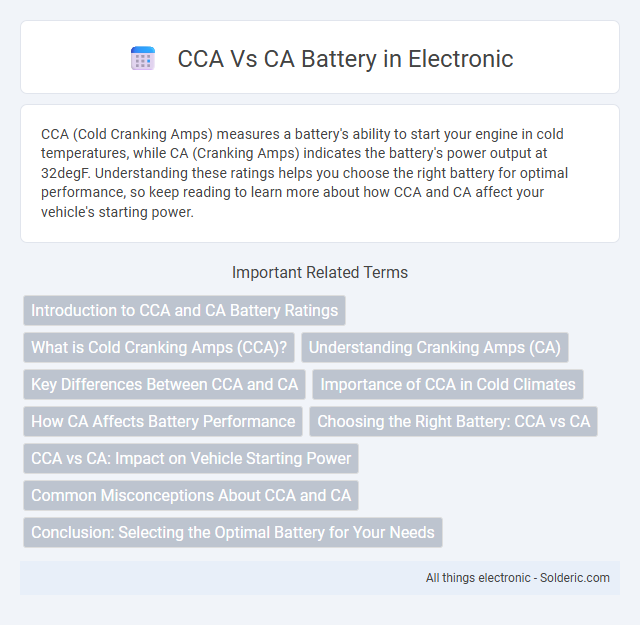CCA (Cold Cranking Amps) measures a battery's ability to start your engine in cold temperatures, while CA (Cranking Amps) indicates the battery's power output at 32degF. Understanding these ratings helps you choose the right battery for optimal performance, so keep reading to learn more about how CCA and CA affect your vehicle's starting power.
Comparison Table
| Feature | CCA (Cold Cranking Amps) | CA (Cranking Amps) |
|---|---|---|
| Definition | Measures battery's ability to start engine at 0degF (-18degC) | Measures battery's ability to start engine at 32degF (0degC) |
| Temperature Standard | 0degF (-18degC) | 32degF (0degC) |
| Test Duration | 30 seconds | 30 seconds |
| Current Rating | Higher demand due to cold temperature | Lower demand compared to CCA |
| Usage | Critical for cold climates and winter starts | Applicable in mild temperature conditions |
| Importance | Key indicator for battery performance in cold weather | Good for moderate temperature starting power |
Introduction to CCA and CA Battery Ratings
Cold Cranking Amps (CCA) measures a battery's ability to start an engine in cold temperatures by indicating the amperage a battery can deliver at 0degF for 30 seconds. Cranking Amps (CA), sometimes called Marine Cranking Amps (MCA), measures the current a battery can supply at 32degF for 30 seconds without dropping below a specific voltage. Understanding the differences between CCA and CA ratings is crucial for selecting a battery that performs reliably under varying temperature conditions.
What is Cold Cranking Amps (CCA)?
Cold Cranking Amps (CCA) measures a battery's ability to start an engine in cold temperatures by indicating how many amps it can deliver for 30 seconds at 0degF without dropping below a specific voltage. This rating is crucial for ensuring reliable engine starts in winter conditions and helps you select the right battery for your vehicle's climate needs. Unlike general amp-hour capacity (CA), CCA specifically addresses cold-weather performance, making it a vital specification when comparing batteries.
Understanding Cranking Amps (CA)
Cranking Amps (CA) measure a battery's ability to deliver current at 32degF (0degC) for 30 seconds without dropping below a critical voltage, indicating reliable engine starting power in mild conditions. Cold Cranking Amps (CCA) represent the battery's performance under colder temperatures, typically 0degF (-18degC), and are more critical for winter starts. Comparing CA to CCA helps determine a battery's effectiveness in various climates, with CA providing insight into starting power in moderate temperatures.
Key Differences Between CCA and CA
Cold Cranking Amps (CCA) measure a battery's ability to start an engine in cold temperatures by indicating the current it can deliver for 30 seconds at 0degF (-18degC). Cranking Amps (CA), also known as Marine Cranking Amps (MCA), represent the current supplied at 32degF (0degC), making CA values typically higher than CCA. Understanding these key differences helps you choose the right battery performance rating based on your climate and starting requirements.
Importance of CCA in Cold Climates
Cold Cranking Amps (CCA) is a critical battery specification measuring the ability to start an engine in low temperatures, directly impacting vehicle performance in cold climates. Higher CCA ratings ensure the battery can deliver sufficient current to overcome increased engine resistance and thickened fluids during cold starts. Compared to ampere-hour (Ah) capacity, CCA is more vital for winter reliability, making it a key factor when selecting a battery for harsh winter conditions.
How CA Affects Battery Performance
Cold Cranking Amps (CCA) measure a battery's ability to start an engine in cold temperatures, while Cranking Amps (CA) indicate performance at 32degF. Higher CA ratings reflect stronger starting power in moderate temperatures, directly influencing overall battery reliability and vehicle ignition efficiency. Batteries with superior CA values deliver enhanced performance during engine startups, ensuring consistent operation in everyday driving conditions.
Choosing the Right Battery: CCA vs CA
Cold Cranking Amps (CCA) measure a battery's ability to start an engine in cold temperatures, making it crucial for vehicles in colder climates, while Cranking Amps (CA) indicate battery performance at 32degF, relevant for moderate temperatures. Selecting the right battery depends on your local climate and vehicle requirements, with higher CCA ratings preferred for reliable cold starts and CA being sufficient in milder conditions. Accurate consideration of CCA versus CA ensures optimal engine starting power and battery longevity tailored to specific environmental demands.
CCA vs CA: Impact on Vehicle Starting Power
Cold Cranking Amps (CCA) measure a battery's ability to start your vehicle in cold temperatures by delivering a high current for 30 seconds at 0degF, whereas Cranking Amps (CA) refer to the current provided at 32degF. CCA is more critical for assessing starting power in freezing conditions, ensuring reliable ignition when temperatures drop below freezing. Your vehicle's performance and start-up reliability depend heavily on a battery with adequate CCA rating matching the climate you operate in.
Common Misconceptions About CCA and CA
Cold Cranking Amps (CCA) and Cranking Amps (CA) are often confused, but CCA measures battery performance at 0degF (-18degC) while CA measures it at 32degF (0degC), leading to different cold-weather starting capabilities. A common misconception is that a higher CA rating means better cold-start performance, but CCA is the true indicator for low-temperature engine starts. Choosing a battery solely on CA ratings can result in inadequate performance in freezing conditions despite seemingly high amp ratings.
Conclusion: Selecting the Optimal Battery for Your Needs
Choosing between CCA (Cold Cranking Amps) and CA (Cranking Amps) batteries depends on your climate and starting requirements, with CCA excelling in cold temperatures by measuring starting power at 0degF, while CA measures performance at 32degF and suits milder conditions. Your vehicle's engine size, typical weather, and usage frequency should guide your decision to ensure reliable starts and longevity. Prioritizing a battery with the appropriate amp rating ensures optimal performance and avoids premature wear or starting issues.
CCA vs CA battery Infographic

 solderic.com
solderic.com